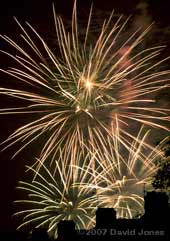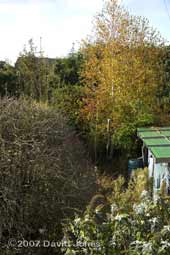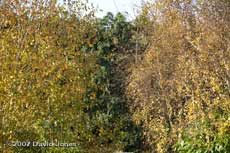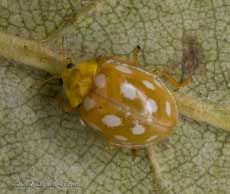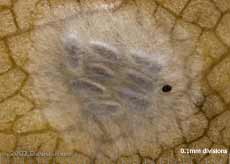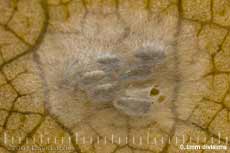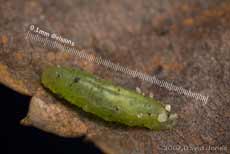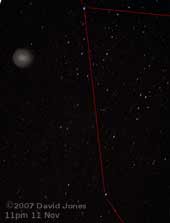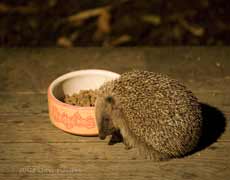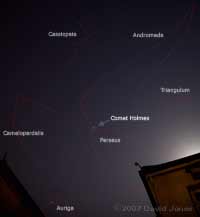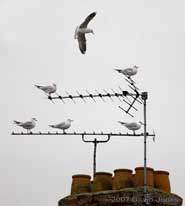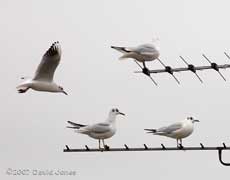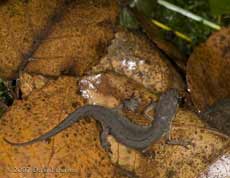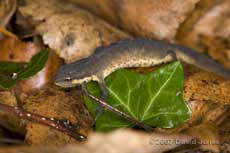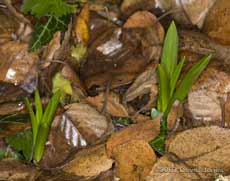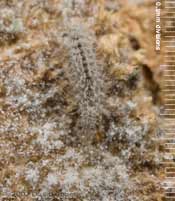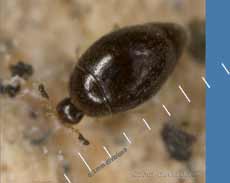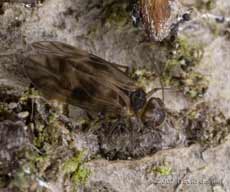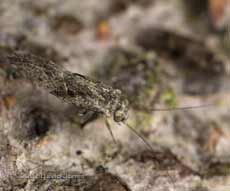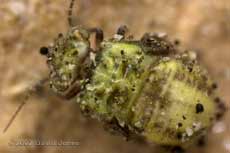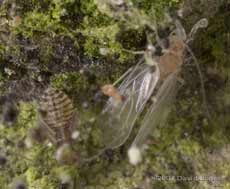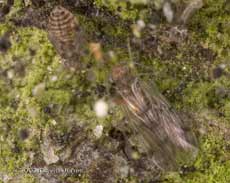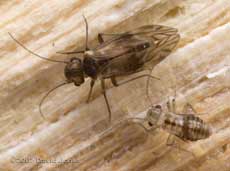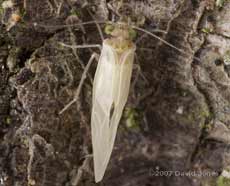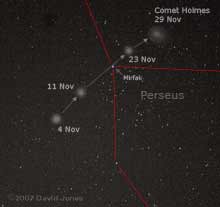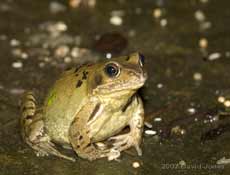Go to the last entry on this page ... ....Go to previous entry5 November - November has started dry and bright, although the same cannot be said for me, as I managed to twist something out of place in my back while relaxing in the garden! It means that at the moment I can only sit by the computer for short periods...
Although today is Bonfire Night, our local public display took place on Saturday (3rd) and as usual I set myself up at the bottom of the garden to watch. This year, with no scaffold tower in place, I used a recently acquired extra tall tripod so the camera could 'see' over my shed. The weather was almost perfect, with just a slight westerly breeze to clear the smoke, but I don't think it was such a good display this year. I will add a few more pictures during the week as it gets more comfortable to sit here for longer periods.
Last night I was out again, this time looking for a cosmic firework of the cold kind, Comet Holmes. Despite the many family firework displays going on in the neighbourhood, the comet was easy to spot. When I took some photographs at around 7.40pm I could see it by facing roughly north-east and looking up about 45 degrees. With only a hint of a tail, Comet Holmes appears as a fuzzy spot, clearly larger than the stars around it, and visible without binoculars. I have read that this 'fuzzy spot' is actually close to a million kilometres in diameter at the moment! In this picture (you need to look at the larger version) I have added lines to show its position in relation to the constellations of Perseus and Casiopeia. Comet Holmes will be visible for quite some time, so it will be interesting to follow its progress across the sky in the months to come. The straight track across the top of the picture was left by an aircraft that was heading more or less south. While I was photographing the comet, at least two hedgehogs were active in the garden, one passing between the legs of the tripod as I fiddled with the camera. During the day, a Greenfinch joined the Goldfinches at the feeder on one of its occasional visits, and as I was writing this entry a Blackbird appeared briefly under the Hawthorn - a rare sight this Autumn.
Talking of Autumn, looking out of the bedroom window you see the contrast between the now almost leafless Hawthorn and the bright colours of the Birch as its leaves prepare to fall. Just in front of the birch, the Rowan has lost most of its foliage, but the remaining leaves, along with its berries are a rich red colour. In the foreground, the Buddleia' flower heads are often used by the Goldfinches, who peck at them while waiting to get to the feeders.
This picture shows our Himalayan Birch along side my neighbour's native Birch. While both trees have started shedding their leaves, the native birch has lost a lot more. Its leaves are smaller and the tree's colour doesn't seem to get quite as rich as ours in the Autumn. I sometimes go up onto my shed roof to inspect the foliage on the native Birch, but I've never found Orange Ladybirds on it, despite the population on my Birch.
9 November - A dry day which, at 9C was colder than the previous two days (highs of around 13C). Night-time temperatures fluctuate quite a lot at the moment. Last night we had a low of just over 5C while the previous night saw a low of over 10C. It continues to remain mainly dry, although a few spots of rain yesterday afternoon were followed by a very heavy, but short-lived shower at the end of the afternoon. This evening it was slightly damp when I went out to get some wood for the burner. Since I took the photographs of Comet Holmes the skies have been mainly cloudy in the evenings so I haven't had a chance to see how much it has moved in relation to the stars. With the temperatures remaining comfortably above freezing, the hedgehogs continue to come for food.
Too high up to photograph, yesterday evening I also spotted a solitary Harlequin Ladybird which was extremely active, perhaps hunting for the very large aphids that can be found on some Birch leaves at the moment - I have still to photograph examples of these.
Included in this photograph is an improved scale (0.1mm divisions) .which I will be using for images taken at high magnifications from now on.
While I understand that these eggs are intended to over-winter before the next generation emerges, at least one egg in this cluster appears to have hatched out already. I have started collecting fallen leaves that have clusters on them so that I can monitor when adults emerge. I'll be keeping the container in the same temperature conditions as the ground below the tree, although they will be sheltered from rain.
It was interesting to see Barkflies featured in a news item today. It seems that there is a new species (Atlantopsocus adustus) in the UK that has come from the Atlantic island of Madeira or the Canary Islands. It has been found at various sites along the south coast of Cornwall. If we get to Cornwall next year I shall have to watch out for it.
10 November - A bright and breezy day, and at 2.25pm it is 13C outside. The breeze is accelerating the leaf loss from the Birch and earlier I spent a few minutes sweeping the leaves of the path. That prompted me to carry out a somewhat unscientific survey. I gathered up a tray full of the leaves and checked them for barkfly egg clusters. It turned out to be quite an interesting survey. I checked a total of 500 leaves, picked at random from the tray, and on them I found 42 adults of Ectopsocus petersi and just 9 Valenzuela flavidus adults present. In most cases there were just single insects on a leaf, although in a few cases I found pairs of adults, but no larger congregations. In contrast to the adult numbers, I found 59 egg clusters of the type produced by V. flavidus and just 3 that I suspect have been produced by E. petersi, these being camouflaged with droppings. While it is possible that I could have missed some camouflaged clusters, I checked each leaf carefully under bright lighting conditions so I don't think many would have escaped my attention! I should point out that the sample contained leaves from both my Himalayan Birch and my neighbour's native Birch, and that there were egg cases on both types.
Those 500 leaves turned up only a few other easily visible animals - three small slugs and two hoverfly larvae, this one standing out like a sore thumb against the mottled browns of the leaf.
This evening I spent a while searching the foliage of the birch tree by torchlight and was able to locate four Orange Ladybirds, the highest count for a while. I also saw several more hoverfly larvae and a couple of dozen barkfly egg clusters (V. flavidus). The silky coverings reflecting the light very well, making it easier to find them at night, unlike the stars, not visible on another cloudy evening.
11 November - A cloudy day with a few showers. When I checked the Birch around 9pm I was able to count five Orange Ladybirds - a pleasant surprise.
A week after I first saw it, tonight the fuzzy spot was larger, but definitely dimmer, and had moved closer to the primary (and brightest) star of the Perseus constellation. That star, at the junction between the two arms of the constellation, is called Mirfak (or Apha Persei). If you click on the image to see the larger version, you will also see one of the pictures from a week ago, with the subsequent passage of the comet indicated on it.
16 November - A bright and frosty morning (-2C at 8.15am), and for the first time this season I have needed to pour hot water onto the birdbath - We had a frost yesterday morning as well, but the birdbath didn't freeze over completely then.
I had already seen visits by at least two different individuals (different sizes) at 7.30, 8, and 10pm, and looking at the food level this morning shows that there was at least one more visitor after I took the photograph.
Over the last couple of days there has been a noticeable reduction in the number of birds coming to feed, with both Sparrow and Goldfinch feeders needing refilling less often. Instead of seeing a dozen or more Goldfinches queuing to feed, I'm only seeing a couple here at any one time. While the colder weather may be a factor, I've also seen a couple of Sparrowhawk visits during the last week (no evidence of it having caught anything here), so that may have caused them to go elsewhere.
23 November - One of those sad times that every family faces sooner or later has meant that I have paid little attention to the garden these last couple of weeks. Hopefully, entries will begin to get more frequent again now. During that time the weather has been rather miserable too, with heavy rain over the last few days, but today the skies have been clear. Tonight, for the first time since my last report about it, I was able to look out for Comet Holmes. However, despite the cloudless skies, the presence of a nearly full moon in the same area of sky meant that there was a lot of glare. By setting up my tripod around 7pm I was able to take advantage of the fact that at that time the moon was still to the east of us and I could set up my tripod in the shade of the house, pointing my spotting scope high towards the east-northeast. Even then, because of the moonlight it wasn't possible to see the comet despite knowing where it should be. However, it did show up on photographs, and the first image shows its new position, having passed the star Mirfak in the last few days.
A couple of garden items to report on - first, the hedgehogs are still coming to feed, including tonight at 8pm, even with the temperature down to around 2C. Back on 29 October I photographed a Green Shield Bug that had hidden itself away in a cluster of bamboo leaves that were held together with silk. Today it is still there. Bird activity has decreased even more over the last week, but at least there is a regular Blackbird visitor under the Hawthorn now.
24 November - After yesterday's brightness, cloud cover returned today, remaining in place after dark - at least it has stayed dry.
Although we don't get to see them in the garden, Black-headed Gulls are overhead quite regularly at this time of year. Today there were numerous of them flying low over us, making quite a bit of noise, and landing on chimney tops and television antennae.
They are all in their winter plumage, having just a dark spot behind the eye rather than the dark brown hood present when they are breeding.
27 November - The skies have remained largely grey since the last entry, with it remaining damp, with some drizzle. Although it wasn't misty when I went outside with a torch this evening, there was enough dampness in the air to show the path of the light beam.
They keep their rear end firmly attached to the exit of their burrows and as soon as the light shines on them they pull themselves back into the burrow. Usually that means that they have disappeared before I can take a photograph, but this one was slower to react!
Having failed to catch any more worms on 'film' I turned my torch onto the leaf litter under the Birch tree. This time it was me who was surprised as I found two Smooth Newts busy hunting amongst the leaves.
This second newt was plumper and had the lighter, boldly speckled underside of a male.
It's been a long time since I last mentioned our frogs. While seeing a newt out and about is an occasional treat, there are always frogs to be seen in or around the ponds. While much of the pond is hidden by vegetation at the moment, I was still able to count a dozen individuals peering out from the duckweed. I must set aside some time to start a bit of pond clearing, a job I prefer to do in stages to avoid a major disruption of the pond.
That reminds me that I need to do other jobs as we head for the end of the year. I have yet to get started on next year's calendar, so that may not be ready by Christmas. Under the Birch there are already signs of the new year to come in the form of Bluebell foliage.
Last night I spent a short time checking the barkflies on the log pile at the bottom of the garden. On a couple of logs there were numerous active adults of Peripsocus milleri (our scarce species). There were no nymphs visible but I didn't move any timber to search for them.
While I didn't take any photographs of the barkflies, I did take a few shots of this tiny insect (probably beetle) larva that seemed to be browsing on mildew (or mould?) on the sawn end of a log. There were several other, similar larvae on other logs. Their hairy bodies are camouflaged with what appears to be similar material to the mildew on the timber.
28 November - After a bit of rain during the night, this morning got off to a dry start, and brighter skies in the afternoon had me heading to the bottom of the garden to look again at life on the log pile. The skies must have noticed me, as it wasn't long before dark clouds rolled in, but I did manage to record a few interesting things before I had to retreat. My primary intention was to take some more photographs of the larvae I spotted yesterday, but didn't get round to them, turning instead to some tiny beetles (the adult stage of the larvae, perhaps??) which can be seen on the same logs and which also seemed to be browsing on the same material as the larvae. They were constantly on the move and at the magnifications I was using it was quite a challenge to get any useable pictures! At less than 0.7mm in length, it leaves me wondering how much smaller beetles can get - I must investigate that at some time.
Nest, I turned my camera towards one of the numerous examples of Peripsocus milleri that are to be seen on the upper surfaces of a couple of the logs. They do not move about very much, and are stationary for much of the time, although the couple I looked at closely were definitely browsing, heads moving from side to side.
While trying to manoeuvre the camera into another position I was surprised by the arrival in the (camera) frame of a very different barkfly. I believe that it is an adult Loensia variegata. Unlike the P. milleri adults (you can see the blurred, out-of-focus shape of the previous individual in the top-right corner of this photograph), this barkfly moved quickly over the log. I didn't see any other L. variegata examples this afternoon.
Yesterday I mentioned not seeing any nymphs in association with the P. milleri adults. Today I did see several nymphs, although these are more likely to be nymphs of L. variegata. These were wandering over the same area as the adults of both L. variegata and P. milleri.
On the same log, I spotted this pair tucked up against a fold in the bark, and protected by a canopy of silk, decorated with faeces and other debris. The nymph on the left looks very similar to those I have seen associated with P. milleri, and the very pale appearance of the adult suggests that it has only just undergone a moult. I took another look at it tonight (some 5 hours after the photograph was taken) and there was little sign of change - I shall have to check it again tomorrow morning.
During that visit, at 7.45pm I noticed that numerous L. variegata adults were visible and active, rather than just the one I saw during the day. I also caught sight of a smaller fly on another log. A brief look through a magnifying lens suggests that it is another species of barkfly, with a dark, almost black body, and almost plain, transparent wings. Perhaps reacting to the bright light of my torch, it headed under a silk canopy where I could just make out a nymph. With rain falling, I decided postpone further investigation of that one until tomorrow. Moving away from barkflies, things are certainly quiet at the feeders at the moment. While I see the odd Goldfinch come to visit I haven't needed to top up the sunflower kernels for the last two days, and the Sparrow feeder hasn't needed more budgie seed for the last three days. The chopped peanuts on the bird table continue to attract Blue, Great Tits and the occasional Coal Tit, as well as the Collared Doves and Wood Pigeons. The Blackbirds are starting to come for raisins more frequently - yesterday I saw four on the tv antennae featured in the gull picture a few days ago, and I often see them moving about in twos or threes. It seems that we have a winter population here at the moment.
29 November - A bright, sunny day with the temperature hovering between 8 and 9C, although the largely clear skies mean that it got colder after dark. First, a follow up to the last photograph from yesterday. The pair of barkflies are still in the same spot under the silk canopy. The adult's body has become a little darker and the wings have now developed some dark patches, although it has some way to go before it is the colouring of the mature P. milleri adult. It isn't possible to get a good, clear picture through the silk, but what I see of the markings in the wings, plus the presence of the canopy itself, is suggesting that this could actually be Ectopsocus petersi. I shall look again tomorrow.
I found this adult and nymph 'pair' (P. milleri) on the end-grain of another log (on which there were also several other nymphs. The abdominal banding on these nymphs is less uniform than that on the nymph in the first picture, reinforcing my thought that the pair under the silk are likely to be E. petersi.
While L. variegata nymphs, with their camouflaged bodies are often very difficult to spot, this freshly moulted adult with its white wings and green eyes casts an almost ghostly figure on the bark. I'm surprised it wasn't hidden away while its wings developed their usual mottled colouring.
30 November - Last night I took advantage of the clear skies to take another look at Comet Holmes.
This image shows the comet last night at around 7.40pm, with an indication of its progress since I first saw it at the beginning of the month. It's a bit of a disappointment to see just how much it had faded during the month, although I'm sure that it is a lot easier to see in places far from light pollution.
The month is ending with heavy rain. Today was cloudy with just a bit of occasional drizzle, and my time was divided between supplementing our log store and preparing for the prospect of high winds tonight. At 9pm it is raining heavily. The wind seems to be getting stronger and it is very mild, with the temperature over 12C, conditions that are just perfect to bring out the frogs! This one is on one of the stepping stones between the bird feeders, hence all the bits around it. I always find myself amused by the way their front feet are turned inwards when they adopt this pose.
Click on images to see larger versions |
|
